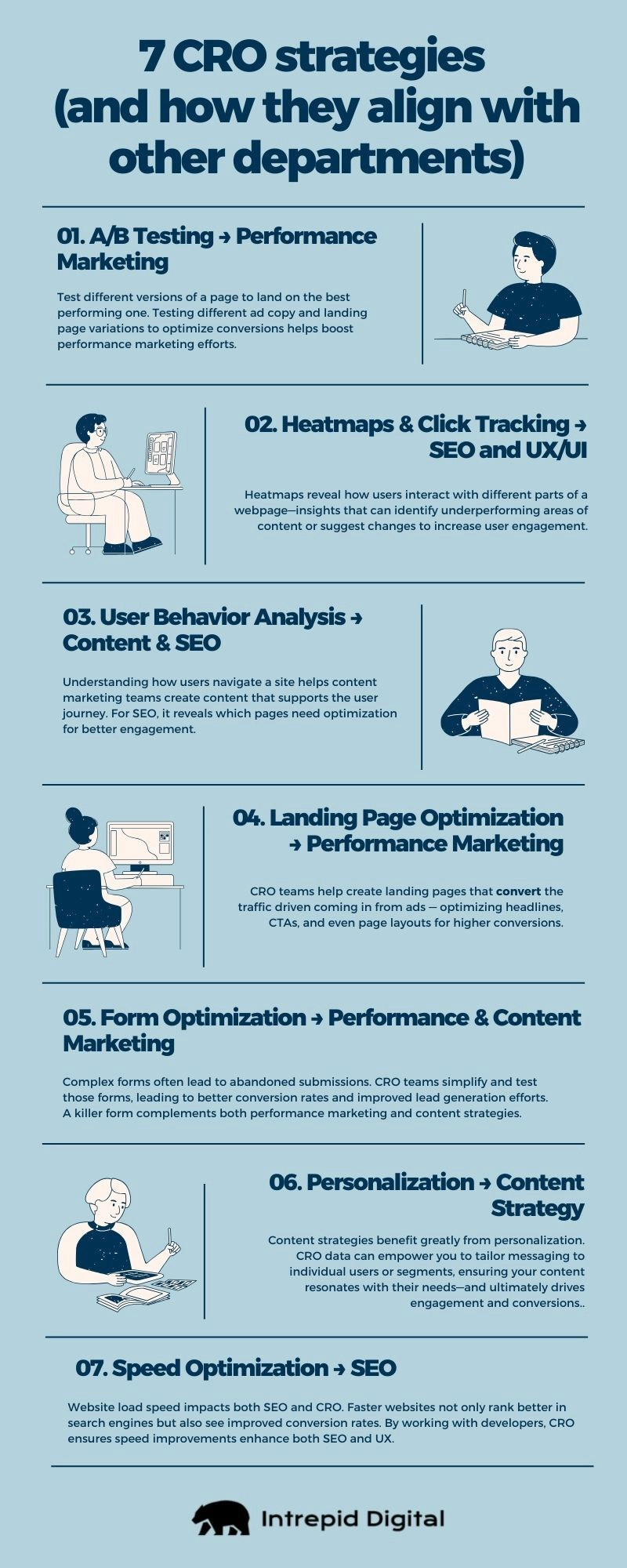
SEO, content strategy, and performance marketing are like runners in a relay race—passing the digital baton to bring visitors to your website.
But getting traffic is only part of the journey. Conversion rate optimization (CRO) is the anchor leg, the final sprinter that turns that hard-won momentum into measurable results. By fine-tuning user experience and guiding visitors toward action, CRO ensures the team finishes strong. In this post, we’ll explore how CRO works hand-in-hand with other marketing disciplines to create a seamless, high-converting customer journey.
1. CRO and SEO: Reel in your customers
CRO and SEO may seem like separate entities, but together, they can benefit each other just as a lure and a fishing reel work together to catch more fish. SEO is your lure—it gets your line in the water and draws the right audience with targeted keywords, optimized content, and high search visibility to drive organic traffic to your site.
But getting the bite isn’t the end goal.
That’s where CRO comes in. CRO is the reel, pulling visitors in and guiding them smoothly toward action—whether that’s filling out a form, making a purchase, or booking a demo. SEO drives organic traffic to your site, while CRO focuses on converting that traffic into leads or customers. When these two departments work in tandem, they can amplify each other’s effects.
But here’s the kicker: the better your CRO, the stronger your SEO. When users stay longer, engage more, and convert at higher rates, search engines take notice—rewarding your site with higher rankings. In turn, improved rankings bring in even more qualified traffic for CRO to convert.
- For example, CRO optimizes landing pages and conversion funnels to ensure the traffic brought in through SEO efforts generates revenue.
- Conversely, improved site usability from CRO often leads to better SEO performance due to enhanced user engagement metrics like reduced bounce rates and longer session durations.
- Don’t just optimize for clicks—optimize for outcomes. Use heatmaps and scroll data to spot where SEO-driven users are dropping off, and adjust your content or UX to keep them moving down the funnel.
2. CRO and content marketing: Tell the right story the right way
As any movie fan who’s disappointed by a remake can tell you—it’s not just what you say, but how you say it that makes it memorable.
Ready for another metaphor? Content marketing is your screenplay: it tells your brand’s story and draws people in with valuable, relevant information. CRO is the director—framing the shot, pacing the scene, and guiding the action to ensure your story actually lands.
In other words, Content marketing creates valuable, relevant content to attract an audience, while CRO focuses on getting that audience to take the next step—whether it’s signing up for a newsletter, downloading a guide, or making a purchase.
By analyzing user behavior, CRO informs where and how content is delivered—from scroll depth insights to CTA placements. A/B testing content layouts, formats, and headlines can reveal what actually moves the audience to act—whether that’s subscribing, downloading, or clicking “Buy Now.”
Through rigorous A/B testing and user behavior analysis, CRO teams can optimize content layouts, CTA placements, and even the type of content that leads to conversions. Aligning content strategy with CRO insights ensures the content not only resonates with the audience but also drives action.
When content and CRO collaborate, your story doesn’t just resonate—it converts.
3. CRO and performance marketing: Boost ROI with 5-star service
Performance marketing brings in customers through paid channels, focusing on specific performance indicators like CPC (Cost Per Click) and CPA (Cost Per Acquisition). CRO enhances the ROI of performance marketing by ensuring that ad clicks lead to conversions.
Think of performance marketing as the host at a busy restaurant—drawing in a crowd with an irresistible menu, glowing reviews, and curbside charm. CRO is the waitstaff and kitchen making sure that once people are seated, they’re delighted, satisfied, and eager to return. In other words, CRO ensures those visits turn into conversions by optimizing what happens next—on the landing page, during the form fill, or throughout the checkout process. By analyzing post-click behavior, CRO teams identify points of friction in the conversion funnel and adjust landing pages accordingly.
Together, they work like a well-run hospitality team: one gets people in the door, the other ensures they stay, order, and rave about it later. If the experience doesn’t live up to the promise, all that ad spend goes to waste. This synergy ensures that money spent on driving traffic is not wasted on ineffective pages, ultimately lowering acquisition costs.
4. CRO and UX: Build delightful experiences
Just as an architect and inspector work together to create an effective, delightful structure, CRO and UX complement each other to create delightful experiences for your visitors. Think of UX as the architect who draws up a blueprint to build the structure, and CRO as the inspector who looks for details to improve the comfort and efficiency of the building.
CRO relies heavily on data-driven insights from A/B tests, heatmaps, and user behavior to improve UX and user interface (UI) design. UX/UI teams create visually appealing and functional designs, while CRO ensures that these designs are not just beautiful but also optimized for conversions.
This collaboration results in seamless, user-friendly journeys that naturally guide users toward completing desired actions.
5. CRO and analytics: Drive your decisions with data
CRO and analytics work hand-in-hand to make informed decisions. Analytics provides the data necessary to identify user behavior patterns, while CRO uses this data to test hypotheses and implement changes that improve conversions. Through continuous monitoring and iteration, these teams ensure that a website always performs at its best, providing a consistent user experience that aligns with business goals.

Instances of CRO synergy in action
What does CRO synergy look like in practice? Here are a few success stories from our clients:
- SEO + CRO Synergy: Clio, a legal software company, optimized its site for organic traffic and saw a massive improvement in rankings but a stagnation in conversions. Intrepid’s CRO team improved the landing page lead generation form UX, with one test resulting in a 26% increase in conversion rate and another test yielding an 18% lift in conversion rate while maintaining SEO gains.
- UX + CRO: An Australian eCommerce site called The Nile used CRO to identify elements of page layout and user flow that were causing friction for visitors. CRO partnered with the UX team to revamp the visual layout and conversion functionality to boost revenue by 54% and increase conversion rate by 11%.
- Performance Marketing + CRO: Clio was running Google PPC ads and wanted to improve CTR and conversion rate performance. Intrepid’s CRO team hypothesized that showcasing more tangible benefits in ad headlines would improve performance. By integrating more “nuts & bolts” value propositions, ad CTR improved by up to 90% while CPA was reduced by as much as 60%.
Key takeaways
CRO plays a vital role in enhancing the effectiveness of other digital marketing departments. It works in collaboration with SEO by improving user engagement, it boosts content marketing efforts by driving actions, and it complements performance marketing by optimizing landing pages for conversions.
CRO strategies such as A/B testing, heatmaps, and landing page optimization directly influence how effectively campaigns and content perform. When departments like SEO, content, and performance marketing align with CRO efforts, they collectively drive better results, leading to improved user experiences and, ultimately, higher conversions.
If you would like to discuss how our CRO services can help maximize your digital marketing ROI, get in touch today.
